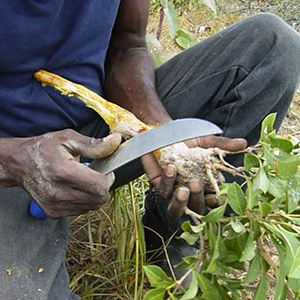Are the most promising medical breakthroughs of the 21st-century 60,000 years old?
 Since time immemorial, the Indigenous people of Cape York Peninsula in northern Queensland have soothed toothache by rubbing it with leaves from the uncha plant. Coming from a plant in the bush rather than a plant in an industrial estate, few outside of the Kuuku I’yu people knew about this treatment until very recently. Even then, Western medicine has been slow to investigate such traditional remedies.
Since time immemorial, the Indigenous people of Cape York Peninsula in northern Queensland have soothed toothache by rubbing it with leaves from the uncha plant. Coming from a plant in the bush rather than a plant in an industrial estate, few outside of the Kuuku I’yu people knew about this treatment until very recently. Even then, Western medicine has been slow to investigate such traditional remedies.
But what if we could prove the uncha plant – as an example – is not only truly efficacious but has unique and significant properties? At the University of South Australia’s Quality Use of Medicines & Pharmacy Research Centre, Dr Susan Semple is leading a team collaborating with the traditional custodians of the Northern Kaanju homelands on Cape York and the Chuulangun Aboriginal Corporation in a true partnership to investigate native plants as sources of medicine and nutrition.
Adding impressive rigour to this project, the team includes: Dr Permal Deo; Dr Bradley Simpson; Dr Chi Ndi, a natural products chemist; Ms Emma Jaunay, a PhD student; Professor Rietie Venter, UniSA’s Head of Microbiology; and UniSA Ventures, which can back up any breakthroughs with the all-important patenting and commercialisation.
While their work is still ongoing, here’s what the team has already learned about the humble uncha plant or Dodonaea polyandra, to give its Western title. In laboratory tests, Dr Simpson discovered its leaves and stems do indeed offer anti-inflammatory properties similar to hydrocortisone. Delving further, he managed to isolate the compounds at work and found some that were previously unknown, including new diterpenoids and flavonoids.
As a result, a patent for these anti-inflammatory compounds has been jointly granted to UniSA and the Chuulangun Aboriginal Corporation for commercial application across Australia, Europe and the US, with David Claudie and George Moreton Senior, representing the traditional custodians, named alongside UniSA researchers as the inventors. The groundbreaking success of this partnership has since been used as a case study by IP Australia and the United Nations.
And that’s just from one plant. Given Australia’s diverse and unique flora, and the Aboriginal people’s longstanding insight into its applications, the potential to uncover more medical breakthroughs is immense. In fact, Australian plants currently in research may contain compounds to treat chronic diseases that are significant contributors to poor health for both Indigenous and non-Indigenous people alike, such as diabetes, cardiovascular disease and chronic infections.
On top of that, the team is also investigating the traditional Aboriginal food plants. It’s hoped that these locally available and culturally significant species could bring nutritional benefits and better health outcomes not just to our first peoples but all Australians.
As significant as they are, health benefits weren’t the project’s only goals, however. Through this project, Aboriginal communities on homeland can derive an income from the intellectual property of their heritage. And it’s also enabling Aboriginal elders to engage with younger generations and pass down knowledge, which is finally being given the respect and value it deserves.



